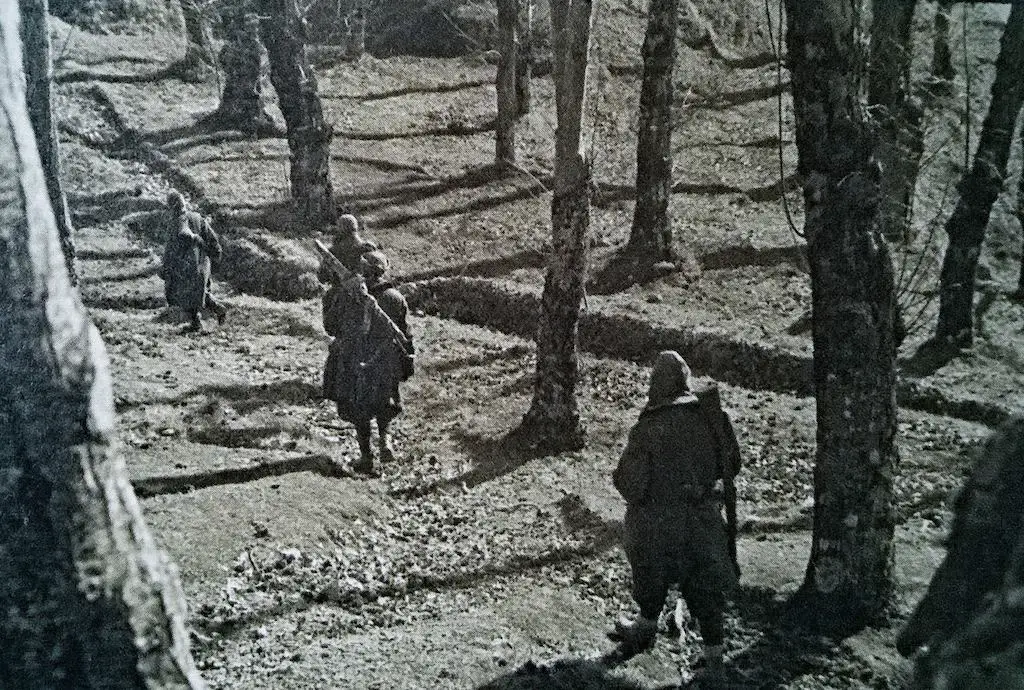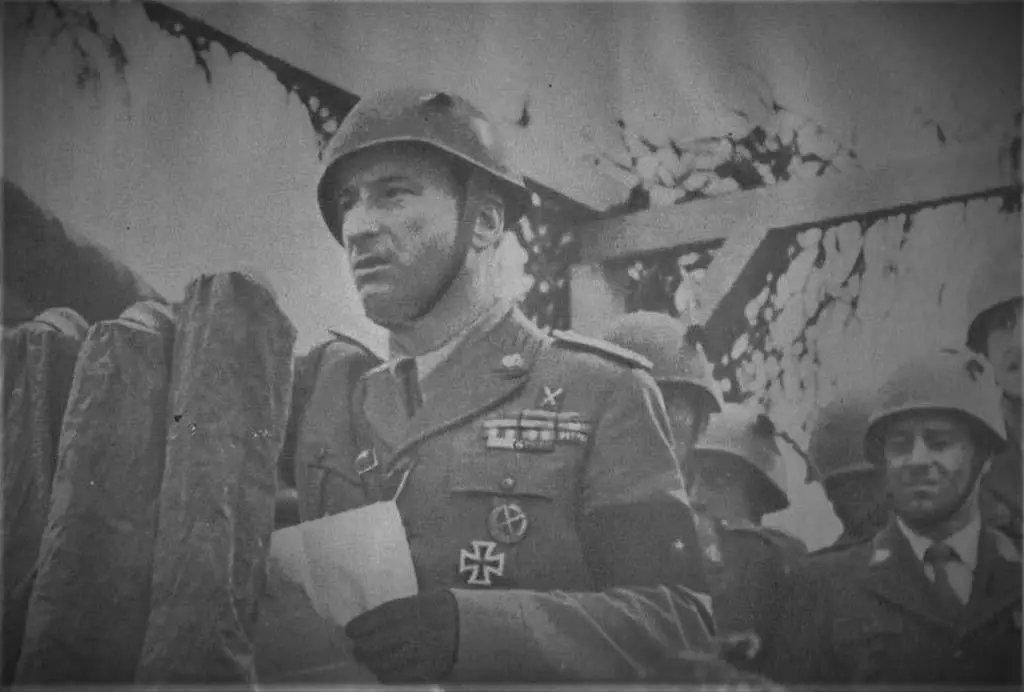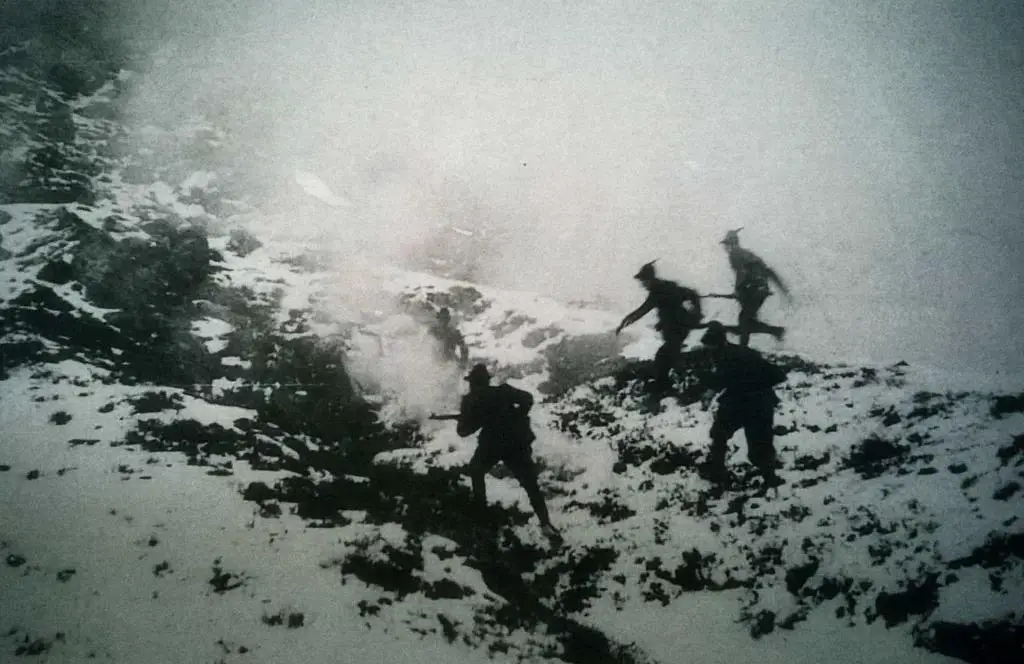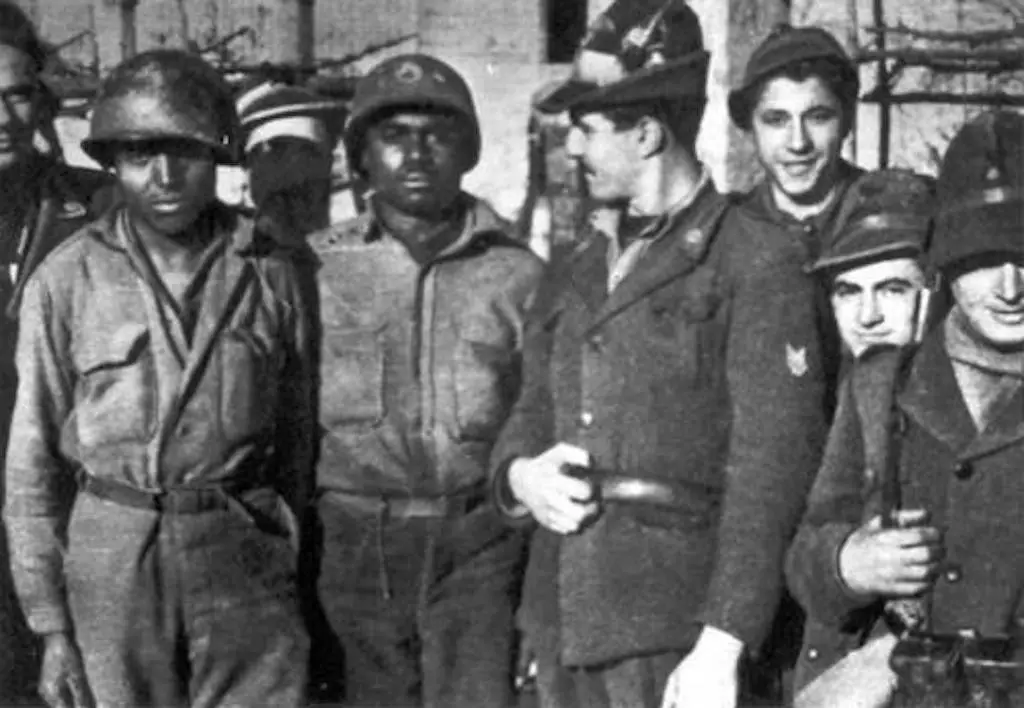What was the Battle of Garfagnana?
The Battle of Garfagnana is the name of the small-scale German-Italian Christmas offensive conducted on the Apennines between 26-28 December 1944. The Germans called it Unternehmen Wintergewitter. In English, it is referred to as Operation Winter Storm. It was the last meaningful feat of arms of the dying Rome-Berlin Axis. It is also one of the last examples of German tactical and operational mastery.

Monterosa Division on patrol on the Garfagnana Front.
Genesis and Preparation
Commander of 42nd Jaeger Division General Walter Jost, deployed on the western sector of the Gothic Line, touched upon operational details of the plan. It had been under consideration since early October 1944 by both the Kesselring staff as well as Benito Mussolini and the Republican Supreme Headquarters.
Related: Italian Social Republic: German Puppet State in Northern Italy
The plan envisioned a strong offensive launching against the western wing of the U.S. 5th Army in the Garfagnana mountain region. This area lies between the Emilia Romagna and Tuscany provinces. Approximately 40,000 men, comprised of two Italian and one German division, would conduct the all-out attack. The force would include lavish tank, artillery, and air support to break through American lines. The goal is to retake Lucca, Pisa and the strategically important port of Livorno. Thus forcing the Allies to withdraw units from central and eastern sectors of the front and call off their offensive in the strategically important Ravenna-Bologna area.
Benito Mussolini and Defense Minister Marshal Rodolfo Graziani warmly supported the plan in this original, wide scope version. A resounding success would be a boost to Italian Republican morale. But the plan would undergo drastic changes, dictated by the bitter reality of the Axis situation.
Problems with the Plan
The original plan soon became a fantasy. Major issues entailed the three required divisions. The Italian “Italia” division still needed to arrive. The Monterosa division only had half its force available, and the German 148th Infantry Division was in poor shape. There were neither tanks, nor aircraft, nor fuel; only a few extra German artillery batteries were provided. Moreover, any attempt to move armored units to the area, or to substantially strengthen the deployed infantry divisions, would be quickly discovered by Allied reconnaissance and partisan spies. The tactical and operational surprise could never be achieved. Not to mention the fact that Allied air forces would quickly make mincemeat of those reinforcements.
Goals of Attack
General Mario Carloni, Commander of the Monterosa Division and General Otto Fretter-Pico, Commander 148th Infantry Division, radically modified the plan and proposed a limited local attack on a narrow front. This attack could be launched without relying on any unlikely reinforcements. Its goals would be:
- Improve Axis defensive positions in Garfagnana.
- Pin American forces down in a secondary zone, preventing them from moving to more vital areas.
- To capture weapons, food, ammunition, and materials.
- Boost the Republican morale.
The revised plan was accepted and preparations began.

General Mario Carloni, Commander of the Monterosa Division.
New Plan for Operation Winter Storm / Unternehmen Wintergewitter
The attack would have invested the American front line between the town of Sommocolonia, east of Serchio river, and Mount Pania Secca, west of the river. It is 20 kilometers as the crow flies. General Fretter-Pico was the overall commander, while the operational leader was General Carloni.
The Monterosa and 148th Divisions plus attached units, comprising 4,600 men, shall split up into three attack columns:
- 1st Column: Italian “Intra” Alpine Battalion; Regimental HQ Company of the 1st Alpini Regiment; Monterosa Division “Cadelo” Recce Group (plus a company of the Italia Division); 2nd Battalion, 6th “San Marco” Marine Regiment; 1st Battalion, German 285th Grenadier Regiment (in fact, the latter unit operated alongside the second column).
- 2nd Column: Italian “Brescia” Alpine Battalion; 2nd Battalion, German 285th Grenadier Regiment.
- 3rd Column: German “Mittenwald” Mountain Battalion; elements, German “Kesselring” Machine Gun Battalion.
Presumably, 80 field guns would be available, to include some additional German artillery batteries such as 1 x 150 mm, 3 x 105 mm, 2 x 75 mm, and 1 x 88mm, plus divisional light infantry guns and mortars.
Role of Each Column
The two German assault battalions of the 3rd column were the best and most experienced units. They were attached to the 148th Division and called “special battalions” in Italian sources. These battalions included well trained and fast assault troops.
The worst ones were the two weak, understrength German battalions of the 285th Grenadier Regiment. Most of their men came from Alsace and had been forcibly enlisted in the Wehrmacht after the 1940 campaign and annexation of their native land. Desertion rate was high. In fact, on 26-27 November, an Italian Alpine company had been sent to keep them under control and to thwart any rebellious attempts.

Anglo-American weapons seized by Monterosa Division in Operation Wintergewitter / Battle of Garfagnana.
The first attack column would operate on the right of the Axis array. Its purpose is to carry out diversionary attacks and take the American first line and the towns of Vergemoli and Calomini. The second, central column, left and right of Serchio river, would break through the American defenses and head for the rear towns of Gallicano, Treppignana and Fornaci di Barga.
The 1,500-strong third column, on the left, is the most important column. It would start first, penetrated the U.S. line, and outflanked it. Its job then is to quickly seize the town of Sommocolonia and make for Barga, Fornaci di Barga, and Pian di Coreglia. A total of 8 km away from their start line.
Misinformation and Rumors
Axis Headquarters did their best in trying to conceal troop and artillery movements. They also purposely propagated rumors about a possible Axis offensive in the Serchio valley. They knew partisan spies and Allied intelligence would sooner or later realize their plans.
Vague information reached U.S. IV Corps and the 92nd “Buffalo” Infantry Division, which was the American unit holding the Sommocolonia – Pania Secca line. An attack was expected on 10 December, so new trenches, fieldworks, barbed wire entanglements, strongpoints, and minefields strengthened the defenses. However, it so happened that the IV Corps also planned a Christmas attack, which should have started 25 December 1944 at 08:00 hours.
Since nothing occurred on 10 December, 92nd Division Major General Edward Almond ordered his troops to make ready an attack, while at the same time keeping a look-out for possible Axis actions. This ambiguous directive caused confusion among 92nd Division’s officers and troops and was one of the causes of their defeat.
Monterosa Order of Battle, Autumn 1944
DVK (Deutsche Verbindungs Kommando, German Liaison Unit) 183
“Cadelo” Divisional Recon Group (HQ, 3 Troops
1st Antitank Company
101st “Ivrea” Replacement Battalion
1st Engineer Battalion
1st Signal Battalion
2nd “Vestone” Replacement Battalion
1st Transport Battalion
“Saluzzo” Operative Battalion
1st (7th) Alpine Regiment:
HQ Company; Light Column; 101st Cacciatori Carri (Tank Hunters) Company; 17th
Company; “Aosta”, “Bassano”, “Intra” Battalions
2nd (8th) Alpine Regiment:
HQ Company; Light Column; 102nd Tank Hunters Company; “Brescia”, “Morbegno”, “Tirano” Battalions
American OOB
The unit bearing the brunt of the Axis onrush was the 370th Regimental Combat Team of Colonel Raymond G. Sherman:
- 1º Battalion, 370th Infantry Regiment
- 2º Battalion, 370th Infantry Regiment
- 2º Battalion, 366th Infantry Regiment
- 598th Field Artillery Batallion
- 92nd Cavalry Reconnaissance
- 366th Infantry Regiment
- Company B, 760th Tank Battalion
- Company A, 317th Engineer Battalion
The Attack
On 24 December 1944, the 92nd Division received orders to call off the scheduled attack and prepare to fend off an Axis offensive which would start 27 December. But the Axis third attack column was ready to go at midnight, 25-26 December.
At 04:50 (3:00 according to some sources) hours, 26 December, elements of the two German assault battalions, coming out from darkness, suddenly attacked the Sommocolonia garrison. They included elements of F Company, 2nd Battalion, 366th Regiment, and supported by some partisans. Some authors state resistance was tough but quickly overwhelmed; others say it lasted all day and the attackers were forced to call for artillery support. The latter account seems to be more credible. When the town finally became occupied by Germans, only 18 defenders managed to disengage and withdraw.
In the morning, 200 men of the Mittenwald battalion seized American positions at Bebbio and Scarpello. These are villages south of Sommocolonia held by the 92nd Recon Troop who withdrew to Coreglia. At 14:00 hours, the German spearheads attacked Barga, and its garrison, the 2nd Battalion, 366th Regiment. Here, too, defenders put up a good fight and the garrison succumbed to German hands the following morning.
In the meantime, Axis mortars opened fire along the whole front and the other two columns started to move forward. The center column in the Serchio valley, east of Serchio river, overcame some weak initial resistances. But American troops there were already hastily retreating and the attackers got to Fornaci almost without a fight. Fornaci fell quickly, although the two German battalions received heavy criticism for their sluggish, hesitant behavior.
You Might Like: Monterosa Division of the Italian Socialist Republic
Italian Column
The all-Italian right column, however, faced a much more vigorous defense. The San Marco had no problems in occupying the village of Molazzano and in pushing back the defenders. But the Regimental HQ Company suffered losses and could not take the village of Brucciano. The Cadelo Group, helped by the Intra battalion which engaged the enemy in diversionary attacks, occupied Calomini. But Vergemoli, defended by troops of the 370th Infantry Regiment, and some partisan groups was a tough nut to crack. A wide minefield, artillery shelling, and intense machine gun and rifle fire stopped the advancing Italian platoons and caused heavy casualties.

The 3rd Alpini Battalion Intra of the Monterosa Division during the Battle of Garfagnana.
Not even the intervention of Axis artillery could dislodge the Americans from their positions. In the evening of 26 December, the town still remained in American hands. The Cadelo Recce Group suspended attacks because the whole U.S. line had crumbled. Vergemoli could have been surrounded and isolated. However, American troops eventually retreated, leaving a partisan group in Vergemoli as cover.
Axis Success
On 27 December, the mini-offensive was virtually over. It had been a remarkable success. In the morning, the German assault column entered Pian di Coreglia. Some patrols went forward as far as the relatively distant village of Calavorno. They reported the enemy continues in full retreat. The other columns also reached their objective points. Consequently, an entire Allied Division gave way in defeat. Nearly 100 prisoners captured, along with many weapons. These included several Browning 12.7 mm heavy machine guns, mortars, bazookas, food, and various materials.

Two African American Buffalo Soldiers from the 92nd Infantry Division are captured as Prisoners of War by the Italian Alpini.
Axis attack forces wedged themselves in an area 20 km wide, 8 km deep.
Allied Mistakes
Surprisingly, even the Allied air forces had been caught off guard. The usually ubiquitous USAAF P-47s did not seriously oppose the enemy’s advance until the morning of 27 December.
It’s difficult to assess Axis losses as the sources don’t give any figure. The left and center columns casualties most likely were negligible. However, the heaviest losses were those of the right column – perhaps 70-80.
As for the 92nd Division, the low prisoner statistics indicates a defeat, but that it also managed to retreat and take shelter in the Allied back-lines. It’s also true that Axis forces did not have the capability to bag thousands of prisoners. On the other hand, during the American retreat, episodes of panic, insufficient resistance, and utter disorganization actually took place, as Gallicano civilian dwellers witnessed.
The Reputation of the African-American Buffalo Soldier
The responsibility, as General Clark himself pointed out, rests almost entirely with the high-level commanders. It does not rest with the black troops nor with their platoon, company and battalion leaders. A night assault took them by surprise. They did what they could do and fought valiantly. A number of black soldiers were later awarded decorations.
In Italian and German officers’ opinion, American black soldiers were not consistently aggressive. But in their defense, they proved themselves stubborn and tough. In several little local attacks during the months of October and November, the Buffalo soldiers fought fairly well.
Unfortunately, General Almond and Colonel Sherman were the first U.S. soldiers to panic in the Battle of Garfagnana. They later tried shamelessly to lay the blame upon the troops, their company and platoon leaders. But it was their muddled orders, their slow reaction, and the misunderstandings which gave rise to the main causes of the American setback. Additionally, the tactical surprise and effectiveness of the left outflanking column.

Buffalo soldiers from the 92nd Infantry Division provide mortar support at Massa, Italy in 1944.
The Allies also erroneously understood Monterosa Gothic Line troops’ morale. A mid-December U.S. intelligence report stated that “The morale in the [Monterosa] Division is very low.” While the Italian unit was not a first class outfit and had its morale troubles, it was far from being a total failure.
It also seems that bad luck afflicted the Americans. The explosive charges placed on some important bridges in order to blow them up in case of a sudden Axis attack did not explode.
A Halt to the Offensive
The success went to Mussolini’s and Graziani’s heads. They, and several Republican military and political representatives, pressed for a continuation of the offensive. In fact, they suggested pouring reinforcements in and directing the victorious columns southwards to Lucca, south-west to Viareggio, or eastward.
But this could never work. From 27-30 December, USAAF aircraft strafed and bombed everything in sight, from stray vehicles to single men to lonely houses. Additionally, German, Italian and American wounded soldiers were attacked in the nearby Camporgiano hospital. The few 20 and 88 mm anti-aircraft guns could not stop the waves of attacking planes.
Moreover, the 8th Indian Division, first a battalion and a company of the 19th and 21st Indian Brigades, then the whole unit, hurriedly rushed to the Garfagnana front and deployed north of Bagni di Lucca. Two Regimental Combat Teams of the U.S. 85th Division formed a front line again. The 1,000 meters high Mount Palodina, which is 4 km south of Gallicano, became an impregnable Allied strongpoint.
In any event, the new Allied line never became tested. As previously decided, the Wintergewitter commanders shut down the offensive and withdrew their troops to better defensible positions. These positions were just one to two kilometers south of the 26 December start line. The withdrawal became complete on 30 December.
Revisionism
The 8th Indian Division simply followed the retreating Axis units and no fighting took place.
In his book “War in Italy – 1943-45. A Brutal Story“, p. 120, Richard Lamb states:
The crack British 8th Indian Division went into the line to replace the 92nd and immediately counter-attacked. Graziani’s Italian troops were no match for fierce, battle-hardened Gurkhas, and Barga was recaptured.
But this is sheer imagination. The Gurkhas recaptured Barga without striking a blow for the simple reason that Germans and Italians had withdrawn and evacuated the conquered territory. In a few patrol actions, they reportedly captured one German and two Italian soldiers. In short, this was the 8th Indian Division’s “counter-attack”.
The Aftermath
Every limited objective of the Battle of Garfagnana became obtained. The U.S. 5th Army was tactically tripped up. Allied reserves became mobilized to a secondary sector. Additionally, morale improved and Italian Republican troops rejoiced in the success. And conversely, some partisan bands and groups felt the hit and scattered during the winter. The Axis gained a slightly better defensive situation on the Western Apennines. In fact, the new line stayed more or less intact until April 1945 during the final Axis collapse.
Given the awful conditions under which the Axis units operated in the Italian theater, and the disproportionate numbers and firepower, it is unthinkable to manage to do more than what was historically achieved. An all-out, Ardennes-style offensive, if successful, would probably have led to the capture of Leighorn and further repulse the 5th Army. But it would never have “driven the Allies into the sea”. In short, an extra German effort in Italy would just have quickened the collapse of the Western and Eastern fronts.
Battle of Garfagnana/Operation Winter Storm/Unternehmen Wintergewitter Map

Battle of Garfagnana / Operation Winter Storm map.
Article provided courtesy Alessandro Gazzi.